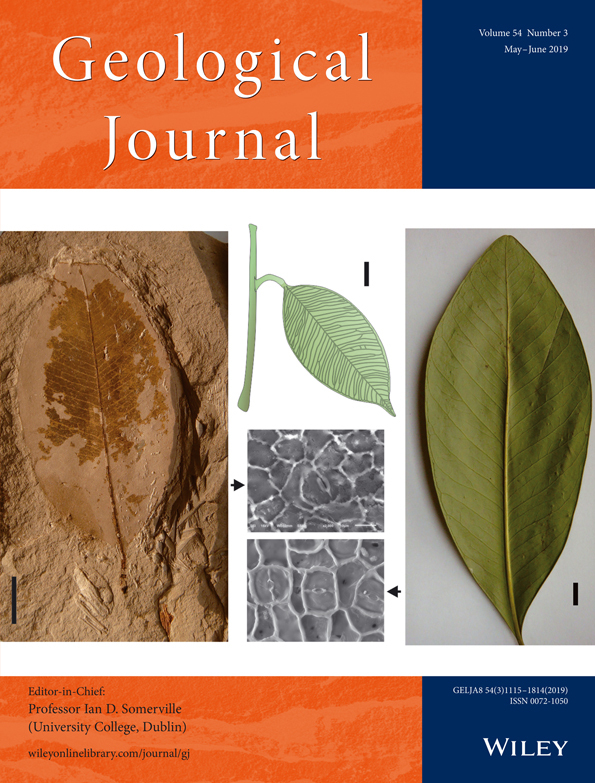The structural deformation characteristics and the control of gold mineralization of the upper Triassic flysch (Langjiexue Group) in Tibetan Plateau
Abstract
Located in the eastern section of the Indus-Yarlung Tsangbo Suture Zone, the Triassic Langjiexue Group is also very important for the distribution of the orogenic gold deposits, such as Bangbu and Zhemulang. Two regional profiles (Jiacha profile and Lang County profile) in the Langjiexue Group have been chosen for systematic mapping. Combing with the method of Ar–Ar dating for mica, this paper provides a detailed analysis of the structural movements and stress periods of the Langjiexue Group, and the relationship between them with the orogenic gold deposits distributed within it, and finally, establish the structural control model for orogenic gold deposits in the Langjiexue Group. The structural deformation of the Langjiexue Group can be divided into 4 stages. In the D1 stage, shallow ductile shear played a dominant role with the principal stress of the reaction in a nearly E–W direction. The main stress of D2 stage was in an obviously S–N direction whose foliation of the axial surface was a ubiquitous phyllitic foliation and foliation. The structures of the D3 stage were superimposed on those of the D2 stage with the main stress of S–N direction. In the D4 stage, the principal stress of the structural movements was in a nearly E–W direction. According to the morphology and spatial positions of the profile folds, the main body of the Songre Formation in the southern parts of the tectonic profiles can be restored into a large reverse antiform, whereas the main body of the Tectonic mélange zone in the northern parts can be restored into a continuous large antiform and synform. Judging by the Ar–Ar plateau ages (56.04 ± 0.72 Ma, 47.98 ± 0.46 Ma) of the sericite in the two quartz veins that were arranged along the axial plane cleavage of the folders in D3 stage, the widely distributed quartz veins in the Langjiexue Group were mainly the outcome of fluid action accompanied by the structural deformation that occurred in the main Indo-Asian collision orogenesis period, which were in consistent with the mineralogenetic epoch of the orogenic gold deposits in this region.
1 INTRODUCTION
For the major orogenic gold deposits in the world that was listed by Goldfarb, Groves, and Gardoll (2001) and Groves, Goldfarb, Gebre-Mariam, Hagemann, and Robert (1998), gold mineralization was originally thought to occur in an accretionary orogenic tectonic setting (e.g., Barley & Groves, 1992; Kerrich, Goldfarb, Groves, Garwin, & Jia, 2000), especially in the outer converge supercontinent cycle or the edge of the inner converge supercontinent cycle. In recent years, several medium to large orogenic gold deposits have been discovered in collisional orogenic belt (e.g., Chai, Sun, Xing, Chen, & Han, 2016; Kong et al., 2017), especially in the Tibetan Plateau in China. At least two important Himalayan period orogenic gold deposit belts have been identified, which are the Ailaoshan orogenic gold belt controlled by lateral shear strike-slip (~30 Ma; e.g., Deng & Wang, 2016; Deng, Wang, Li, Li, & Wang, 2014) and the Yarlung Tsangpo orogenic gold belt controlled by forward collision extrusion (~50 Ma; e.g., Hou & Cook, 2009; Jiang, Nie, Hu, Lai, & Liu, 2009; Sun et al., 2015, 2016; Zhang et al., 2017). Nowadays, ore deposit scientists in China have devoted themselves to the study of ore-forming dynamics, distribution law, and prospecting marks for the orogenic gold deposits in the collision environment that achieve the remarkable development of gold metallogenesis from the accretionary orogeny to the collision orogeny (e.g., Deng, Wang, Li, & Santosh, 2015; Shi et al., 2010; Yuan et al., 2010). The orogenic gold deposits are closely related to the tectonic movements and the structures control the migration and precipitation process of gold. The Yarlung Tsangpo orogenic gold belt is formed under the background of Indo-Asian main collisional period (65–41 Ma; e.g., Hou & Cook, 2009; Liu et al., 2016, 2017; Wang, Li, & Hu, 2003) with the peak metamorphism happened at about 50 Ma. The scale of crustal shortening reaches to 130 km (Ratschbacher, Frisch, Liu, & Chen, 1994) with numbers of folds, thrusts, and superimpositions developed. The tectonic grid is quitely developed, which has laid a good precondition for the formation of orogenic gold deposits.
The Triassic Langjiexue Group, which is located in the eastern part of the Indus-Yarlung Tsangbo Suture Zone (IYS), is quite important for the distribution of orogenic gold deposits, such as the Bangbu large orogenic gold deposit, Zhemulang medium orogenic gold deposit, and also a series of gold ore occurrences. The Langjiexue Group has always been a research hotspot, but almost all the studies focused on its source and representative geodetic significance. For example, the Langjiexue Group was always regarded as a part of the Tethyan Himalayan sequence, just the stable continental margin in northern Indian (Gaetani & Garzanti, 1991; Gansser, 1991; Huang & Chen, 1987; Wang, 1983). In the late 1980s, it was argued that the Langjiexue Group may not belong to the Himalayan sequence, and it was mapped as an independent stratum structure unit (Pan, Ding, & Yao, 2004); however, no direct evidence has been found to support this argument. Li et al. (2010) conducted a geochronological study for the detrital zircons of the metasandstones in the strata of the Songre and Nieru formations that belong to the Langjiexue Group of the Renbu mélange belt. They argued that the Langjiexue Group had an obviously different material source from the Tethyan Himalayan; specifically, the Langjiexue Group was sourced from the Lhasa terrane, rather than the Indian terrane as in the conventional view. Based on research into detrital zircons, Cai et al. (2016) concluded that the Langjiexue Group and Nieru Formation were sourced from northwestern Australia. In addition, some people hold the view that the Langjiexue Group had more than one provenance; it might be sourced from the Lhasa terrane, Qiangtang terrane, Western Australia, and other parts of Gondwanaland (Li, Mattern, Zhang, Zeng, & Mao, 2016).
Due to the late start of the research into the orogenic gold deposits in the IYS, the structural deformation characteristics and their control on the orogenic gold mineralization in the Langjiexue Group were not given enough attention. Based on this case, we select two regional profiles (Jiacha profile and Lang County profile) in the Langjiexue Group for systematic mapping. Using the method of Ar–Ar dating for mica, this paper provides a detailed analysis of the structural movements and stress periods of the Langjiexue Group, and the relationship between them with the orogenic gold deposits distributed within it, and finally, establish the structural control model for orogenic gold deposits in the Langjiexue Group.
2 REGIONAL GEOLOGY
The IYS in China is more than 2,000 km long (Hou et al., 2007), and consists of a western section along the Ga'er River that is in contact with the IYS, a central section, and an eastern section along the Yarlung Tsangbo River that turns toward Burma in the south. The IYS is also the tectonic boundary that separate the Lhasa terrane in the north from the Himalayan terrane in the south (Hou & Cook, 2009; Yin & Harrison, 2000; Figure 1a). Renbu–Motuo is its north boundary fault, whereas the Qiongduo River–Zhari is the south boundary fault. The Lhasa terrane has a mid-Proterozoic and early Cambrian basement covered by a sequence of Palaeozoic–Mesozoic sediments that are dominated by Ordovician–Triassic shallow-marine clastic sediments (Burg & Chen, 1984; Kind et al., 1996; Mo et al., 2003, 2007), whereas the Himalayan terrane is composed by the Precambrian metamorphic basement originated from the northern margin of the Indian terrane and marine sediments of Palaeozoic, Mesozoic, early Eocene, and continental sediments since Oligocene (Li et al., 2010; Mo et al., 2009). The Himalayan terrane can be further divided into Tethyan Himalayan sequence, Greater Himalayan sequence, Lesser Himalayan sequence, and Himalayan foreland basin from north to south (Figure 1b; Liang et al., 2011). Three subtectonic units have been recognized in the IYS (Pan et al., 2006, 2012): the Yarlung Tsangbo ophiolitic mélange belt, the Zhongba block in the western section, and the Upper Triassic flysch (Langjiexue Group) in the eastern section. The IYS is almostly controlled by the north-dipping thrusting fault system and reformed by the large reverse thrusting system of south dip (Lai et al., 2015).
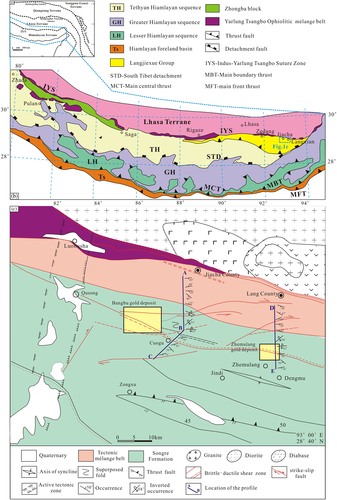
The Yarlung Tsangbo ophiolitic mélange belt distributes along the IYS, from west to east, with a length of 2,000 km and width of 5–20 km. It was divided into two branches by the Zhongba block in the western section, whereas the same by the Langjiexue Group in the eastern section. The belt contains lots of blocks of clastic rock, limestone, and ophiolite composed of dunite, harzburgite, lherzolite, layered gabbro, swarm of mafic dike, mantle-type plagiogranite, pillow basalt, and radiolarian siliceous rock in fine-grained turbiditic matrix or strongly deformed tectonic mélange (Geng et al., 2004; Li et al., 2010; Li, Liu, Wei, & Liu, 2011; Pan et al., 2006). Three types of ophiolites, which are suprasubduction zone type (Chen et al., 2003; Hu et al., 2002; Li et al., 2009; Li et al., 2016; Niu et al., 2006), mid-ocean ridge type (Hu et al., 2002; Zhao, Xu, & Liang, 2015), and rifting type (Hu et al., 2002) have been recognized in the central part of the belt.
Located in the western section of the IYS, the Zhongba block stretches like a wedge in a northwest–southeast direction. The block stretches eastwards as far as Saga, and westwards as far as Zhada. It is a long, narrow corridor clamped by the south and north subzones of the ophiolitic mélange belt in the western section of the Yarlung Tsangbo River. Its main exposed parts are the neritic sedimentary phase of the Devonian system and the continental sedimentary strata from the Pliocene series of the Neogene system to the Pleistocene series of the Quaternary system (Li, Wang, Li, Wei, & Chen, 2014). According to the existing data, both the Zhongba block and the continental margin of the Himalayan on its south belong to the Palaeozoic sedimentary system of the northern margin of Gondwanaland. From the Lower Triassic epoch, the back-arc rift and rift basin of the Yarlung Tsangbo River evolved into a rear arc oceanic basin, and then the Zhongba block was split from the northern part of Gondwanaland, thus forming a microcontinent independent from the Yarlung Tsangbo oceanic basin (Pan et al., 2004; Sun et al., 2013).
The Langjiexue Group is located in the eastern section of the IYS (Figure 1b) whose northern boundary is the Yarlung Tsangbo ophiolitic mélange belt and its southern boundary is the Qiongduo River–Zhari fault. It stretches westwards as far as Lazi, and eastwards as far as Milin via the Bailang–Qusong zone. Overall, the Langjiexue Group is distributed in a nearly E–W direction with its main exposed part is the complexes of the Upper Triassic epoch. The Langjiexue Group whose stratum contains mainly a low metamorphic quasi-flysch turbidite series of low greenschist facies intercalated with a volcanic series that is also a tectonic slice comprising ophiolites, ophiolitic mélange, archibenthic–abyssal flysches of the Gaxue Group, silica rocks, and basic lavas (Li, Zeng, & Wang, 2003; Zhang et al., 2015; Zhang, Zhang, Zeng, & Han, 2014). The deformations in the Langjiexue Group are extremely complex. Between different terranes or strata are complexly developed faults, crushed zones, schistositized zone faults, and folds. Some orogenic gold deposits and many gold occurrences have been found in the Langjiexue Group such as Bangbu and Zhemulang. The Langjiexue Group has already been regarded as a favourable place for orogenic gold mineralization in IYS.
3 GEOLOGY OF GOLD DEPOSITS IN LANGJIEXUE GROUP
3.1 The Bangbu gold deposit
The Bangbu deposit is a large collisional orogenic gold deposit, which is located in the middle section of the Qusong–Cuogu–Zhemulang brittle–ductile shear zone (Figure 1c) and on the north side of the Jindi–Lunong multiple syncline (Sun, 2012), and it is also the part of the Langjiexue Group with the strongest deformation.
The wall rock of the Bangbu deposit is the phyllite of Upper Triassic Songre Formation with strong beresitization. Three groups of faults that are nearly E–W direction, ENE direction, and S–N direction are developed in the mining area (Figure 2), during them, the E–W direction fault is the branch structure of the north side of the Qusong–Cuogu–Zhemulang brittle–ductile shear zone with the characteristic of left line shear; ENE direction fault is the secondary fracture of the E–W direction fault with the properties of compression and torsion thrust nappe. Quartz veins with gold mineralization are developed along the ENE faults. The N–S direction fault with the compression and strike slip property is formed under the extensional mechanism, quartz veins are partially filled, but none of them has gold mineralization.

The main type of ores at Bangpu is quartz vein type. Three stages of quartz veins have been identified (Sun, 2012): (a) hooked quartz vein (Figure 3a), composed by creamy white quartz; this kind of quartz vein penetrates along the stratification in veinlet, lenticular, or irregular massive, locally curved to form folds with stratum in hooked, enterolithic, or vermicular shape. A small amount of euhedral pyrite particles can be seen in this kind of quartz vein but with little gold mineralization. They must be formed before the gold mineralization as the hooked quartz veins deformed with the surrounding rock and being cut by the auriferous and vertical quartz veins. (b) Auriferous quartz vein (Figure 3b,c), which is mainly composed by white quartz with iron staining in the near surface. This kind of quartz vein has pyritization and gold mineralization, also with galena, sphalerite, chalcopyrite, and melnikovite. Gangue minerals mainly conclude sericite, chlorite, and ferric dolomite. (c) Vertical quartz vein (Figure 3d), which is made up by milky white lump quartz with obvious miarolitic structure. This kind of quartz vein penetrates along the tensional fracture with no pyritization or gold mineralization. They were formed after the gold mineralization as they had cut across the hooked quartz vein, auriferous quartz vein, and also the metamorphic wall rock.
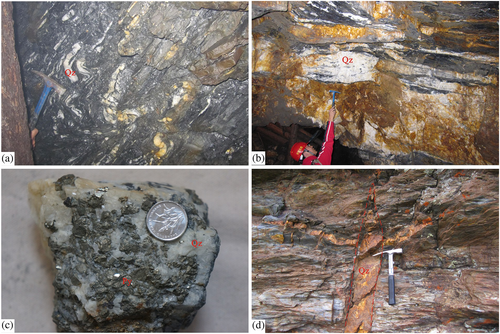
Fluid inclusions indicate the ore-forming fluids were in a CO2–H2O–NaCl–CH4–N2 system. The δ18Ofluid (2.0–7.9‰), low δDV-SMOW (−104‰ to −49‰), and δ13CV-PDB (−11.7‰ to −7.0‰) for auriferous quartz veins suggest ore-forming fluids were mainly metamorphic in origin, with addition of formation water. Pyrites in the quartz veins have δ34SV-CDT values of −0.1‰ to 3.4‰, indicating sulphur mainly derived from the deep metamorphic water. Pb isotopic data indicate ore-forming materials of Bangbu were probably derived from the Langjiexue Group (Pei et al., 2016).
3.2 The Zhemulang gold deposit
The Zhemulang deposit is a medium collisional orogenic gold deposit, which is located in the eastern section of the Qusong–Cuogu–Zhemulang brittle–ductile shear zone. The wall rock of the deposit is the Songre Formation comprising carbonaceous sericite phyllite, feldspar–quartz metamorphic sandstone with the alteration of silicification, muscovitization, sericitization, and carbonation (Zhou et al., 2011). A mount of quartz veins are visible in the deposit that penetrate along the stratification or tensional fracture in veined or lenticular shape in unequal size. The ore type is relatively single that is dominated by the gold–pyrite–limonite bearing cracked quartz vein. The main metallic minerals contain pyrite, chalcopyrite, galena, and sphalerite, but the amount is less than 3%.
The ore-forming fluids of the Zhemulang gold deposit is featured by high content of CO2, low salinity, low to moderate homogenization temperature, and low density, which is similar to those of typical orogenic gold deposits. H–O–C isotopic analyses show that δDV-SMOW = −107.5–−36.7‰, δOfluid = 4.1–5.5‰, δ13CV-PDB = −11.5–−9.6‰ in Zhemulang gold deposit, indicating that the ore-forming fluids were mainly composed by metamorphic fluid, with addition of mantle-derived fluid (Zhou et al., 2011).
4 STAGE OF STRUCTURAL DEFORMATION IN THE LANGJIEXUE GROUP
This paper studies two tectonic profiles in Jiacha County (A–B–C, Figure 1c) and Lang County (D–E, Figure 1c) of the Langjiexue Group. The northern parts of the two tectonic profiles are the Tectonic mélange zone, which comprises the matrix (including siltstones, mudstones, and fine sandstones) and a small quantity of foreign limestones, pillow basalt, and gabbros. The rocks have experienced an intense tectonic transposition and low-grade metamorphism with phyllite rocks play a dominant role. The southern parts of the two tectonic profiles are the Songre Formation of the Langjiexue Group, which comprises black–grey carbonaceous sericite phyllites and low metamorphic feldspathic quartz sandstones (Figures 4 and 5a,b). These rocks have experienced a tectonic transposition and low-grade metamorphism. According to the morphology and spatial positions of the profile folds, the main body of the Songre Formation in the southern parts of the tectonic profiles can be restored into a large reverse antiform and the main body of the Tectonic mélange zone can be restored into a continuous large antiform and synform (Figure 4), which maintain contact with each other through a reverse fault. Orogenic gold deposits, for example, the Bangbu and Zhemulang deposits, are distributed in the studied area (Figure 1c).
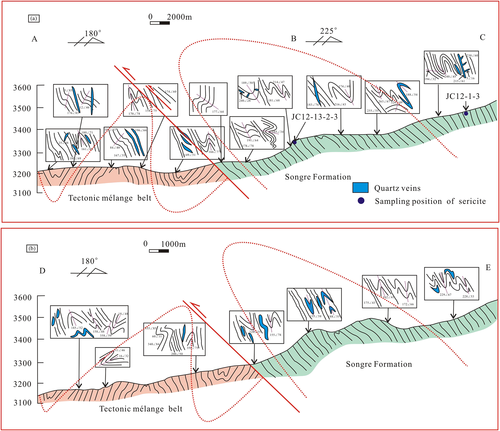

According to the survey of the structures of the Jiacha and Lang County profiles, the Langjiexue Group has undergone strong metamorphism and deformation, secondary structural development and multiperiod fold superimposition are the most significant. According to the profile survey for the part of the Langjiexue Group with the strongest deformation (the Bangbu gold deposit), the structural deformations of the Langjiexue Group can be divided into four stages. In the first stage (D1), the rootless hook-like and closed homocline minor folds in the phyllite rocks were formed, also an intense foliation replacement occurred between the phyllitic foliation S1 and original bedding S0. The pitch direction of hinge was 190° to 230°, whereas the angle of pitch was 20–50° and the angles of inclination on both sides were 30–50° (Figure 6a). In the second stage (D2), the phyllitic foliation S1 developed into closed isoclinic minor folds S2, the pitch direction of hinge was 80° to 120° or 190° to 250°, whereas the angle of pitch was mainly 10–40° (Figure 6b). In the third stage (D3), the S3 folds outcropped to display small and medium-sized semiclosed equal-thickness or angular folds (which were usually asymmetric), the pitch direction of hinge was 90° to 100°, and there existed nearly E–W kink bands and thrust faults (Figure 6c). In the fourth stage (D4), broad and gentle folds were formed (Figure 6d), which were accompanied by N–W and NNW left lateral faults.
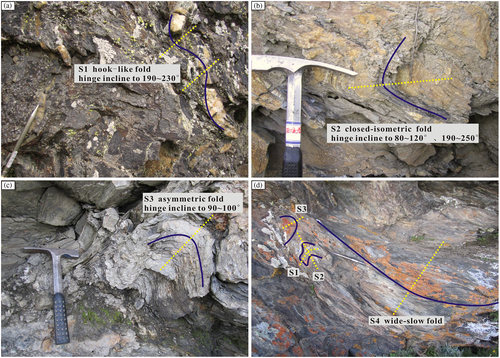
The structural deformation characteristics show that the Langjiexue Group has undergone at least four stages of changes in the tectonic stress field. In the D1 stage, shallow ductile shear played a dominant role and the Langjiexue Group experienced a metamorphism of low greenschist facies. Statistics relating to the fold hinge L1 are shown in Figure 7a, which indicate that the principal stress of the reaction was in a nearly E–W direction. Due to the late structural superimposition and reformation, the tectonic features of ductile shear were mostly still evident and had obvious plastic deformation features. Meanwhile, quartz veins developed along the slip planes of the folds were in hook-shaped or sausage-shaped. In the D2 stage (for which statistics relating to the fold hinge L2 are shown in Figure 7b), the principal stress of the structural movement was in an obviously S–N direction, whereas the foliation of the axial surface of this stage was just the ubiquitous phyllitic foliation and foliation, and they were perpendicular to and obliquely intersected with the fold axis. Meanwhile, a regional fault zone in a nearly E–W direction was formed, which was a part of the Qiongduo River–Zhari Fault and Qusong–Cuogu–Zhemulang brittle–ductile shear zone. Some directionally arranged extruding lenticular bodies were developed in different tectonic rocks and the structural movement of this stage gave birth to high-angle faults regionally, which possessed strike slip properties. The structures of the D3 stage were superimposed on those of the D2 stage with the S3 folds developed and bent along the S2 folds mainly in the form of twist compression along with a local tenso-shear property. At the meanwhile, some kink bands and thrust faults were developed in a nearly E–W direction. The occurrence statistics on the thrust faults of this stage (Figure 7c) show that the principal stress of the D3 state was in a nearly S–N direction. In the D4 stage, the principal stress of the structural movements was in a nearly E–W direction. The deformations produced broad and gentle folds arranged in a NW direction under the left lateral twist action in a NWW direction. These folds were accompanied by multiple groups of left lateral high-angle extension faults in NW and NNW directions, and the faults were mostly filled by steep quartz veins, which cut through the early stage strata.
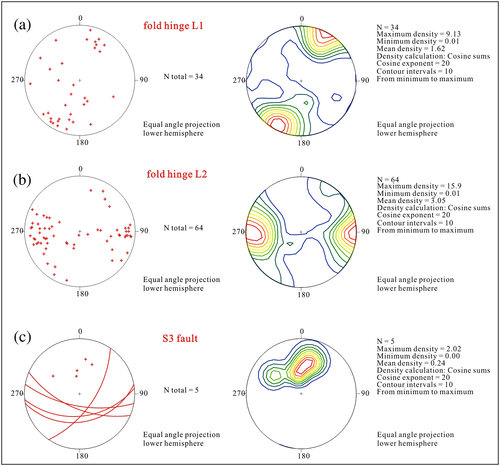
5 Ar–Ar CHRONOLOGY OF SERICITE
5.1 Sample preparation
The ivory coarse-grained quartz veins filing along the axial plane cleavage of the third stage fold deformation are widely distributed in the Songre Formation of Jiacha and Lang County profiles (Figure 5c,d). They have width of 1–15 cm with comb structure growing perpendicular to the vein wall. The quartz veins own miarolitic structure in the central part commonly and are accompanied by sericite in the vein margin occasionally. Two sericite samples (JC12-1-3 and JC12-13-2-3; Figure 2) from the sericite-bearing quartz veins are collected for Ar–Ar dating.
5.2 Analysis method
The Ar–Ar chronology analysis is conducted in the Ar–Ar isotope chronology Laboratory of Institute of Geology, Chinese Academy of Geological Sciences. All minerals for analysis were purified by magnetic separator, then being cleaned by the ultrasonic treatment. The cleaned samples were wrapped by aluminium foil and then were sealed into quartz bottle and being irradiated for 1,440 min in the nuclear reactor (The Swimming Pool Reactor, Chinese Institute of Atomic Energy, Beijing). The reactor delivers a neutron flux of 2.65 × 1013 n cm−2 s−1; the monitor irradiated together with the samples is an internal standard: Fangshan biotite (ZBH-25) whose age is 132.7 Ma and its potassium content is 7.6%.
The samples were heated by graphite furnace. The heating-extraction duration for each temperature increment was 10 min and then the released gases were purified for 20 min. After the purification, the gases were analysed by Mass Spectrometer GV Helix MC. The analysis for each temperature increment included 20 cycles that needed to regress to time zero to get the measured isotopic ratios. Then, the measured isotopic ratios were corrected for the mass discrimination, atmospheric Ar component, blanks, and irradiation-induced mass interference. The correction factors of interfering isotopes produced during irradiation were determined by analysis of irradiated pure K2SO4 and CaF2 whose values are (36Ar/37Ar)Ca = 0.0002398; (40Ar/39Ar)K = 0.004782; (39Ar/37Ar)Ca = 0.000806. All 37Ar were corrected for radiogenic decay. The decay constant of 40K used is λ = 5.543 × 10−10 a−1 (Steiger & Jager, 1977). The age spectra and irochron were done by program ISOPLOT of Ludwig (v2.49; 2001). The plateau age error is 2σ error. Detailed analysis techniques can be seen in Chen, Zhang, Zhang, Jin, and Wang (2006) and Zhang, Chen, Chen, and Liu (2006).
5.3 Results
Detailed 40Ar/39Ar results are showed in Table 1. JC12-1-3 achieves a smooth age plateau yielding the plateau age and isochron age of 56.04 ± 0.72 Ma (2σ; Figure 8a) and 55.1 ± 2.3 Ma (NSWD = 2.3; Figure 8b), respectively, initial ratio of 40Ar/36Ar is 312 ± 44. One to four stage age plateau of JC12-13-2-3 fluctuate to some extent that could be the effect of hydrothermal process in the later stage as the sericite is formed a little earlier than quartz. The flat age plateau is highlighted in the temperature range of 950–1,150 °C, which is just the five to nine stage with 52.4% 39Ar of the total release. JC12-13-2-3 achieves plateau age and isochron age of 47.98 ± 0.46 Ma (2σ; Figure 8c) and 47.0 ± 3.0 Ma (NSWD = 3.6; Figure 8d), respectively, initial ratio of 40Ar/36Ar is 349 ± 200. The plateau age and isochron age of the two samples fit each other well and initial ratios of 40Ar/36Ar show no difference with the atmospheric value (295.5) within the error range, indicating no existence of the excess Ar. The acquired ages are believable that can represent the formation age of sericite (the homogenization temperatures of fluid inclusions in symbiotic quartz are lower than 300 °C).
| JC12-1-3 sericite. W = 35.55 mg; J = 0.002668; total age = 56.2 Ma | ||||||||||
|---|---|---|---|---|---|---|---|---|---|---|
| T(°C) | (40Ar/39Ar)m | (36Ar/39Ar)m | (37Ar/39Ar)m | (38Ar/39Ar)m | 40Ar (%) | F | 39Ar (×10−14 mol) | 39Ar (Cum. %) | Age (Ma) | ±1σ (Ma) |
| 600 | 200.9729 | 0.6583 | 69.1577 | 0.176 | 5.65 | 12.0157 | 0.01 | 0.22 | 57 | 55 |
| 760 | 17.549 | 0.0194 | 0.9376 | 0.0167 | 67.67 | 11.8837 | 0.64 | 22.12 | 56.31 | 0.76 |
| 820 | 13.958 | 0.0067 | 0.4936 | 0.0137 | 86.02 | 12.0113 | 0.79 | 49.29 | 56.9 | 0.67 |
| 880 | 12.4978 | 0.0036 | 0.5809 | 0.0126 | 91.85 | 11.4845 | 0.72 | 74.21 | 54.45 | 0.67 |
| 930 | 13.2262 | 0.0042 | 0.5529 | 0.0131 | 90.82 | 12.0173 | 0.3 | 84.71 | 56.9 | 1.1 |
| 990 | 15.2551 | 0.0094 | 2.4773 | 0.0124 | 82.92 | 12.6742 | 0.15 | 89.73 | 60 | 3.5 |
| 1,100 | 13.9323 | 0.007 | 0.2437 | 0.0123 | 85.24 | 11.8779 | 0.29 | 99.75 | 56.3 | 1.3 |
| 1,300 | 325.4054 | 1.082 | 37.3723 | 0.0234 | 2.56 | 8.5901 | 0.01 | 100 | 41 | 75 |
| JC12-13-2-3 sericite. W = 35.21 mg; J = 0.002770; total age = 45.2 Ma | ||||||||||
|---|---|---|---|---|---|---|---|---|---|---|
| T(°C) | (40Ar/39Ar)m | (36Ar/39Ar)m | (37Ar/39Ar)m | (38Ar/39Ar)m | 40Ar (%) | F | 39Ar (×10−14 mol) | 39Ar (Cum. %) | Age (Ma) | ±1σ (Ma) |
| 700 | 41.1872 | 0.1285 | 2.1045 | 0.0452 | 8.18 | 3.3755 | 0.11 | 0.71 | 16.8 | 3 |
| 760 | 12.4375 | 0.0211 | 0.6562 | 0.0183 | 50.28 | 6.2565 | 0.52 | 4.13 | 31 | 0.6 |
| 820 | 9.7951 | 0.0073 | 0.1398 | 0.0141 | 78.06 | 7.6473 | 1.47 | 13.81 | 37.82 | 0.47 |
| 860 | 9.4741 | 0.0032 | 0.27 | 0.0135 | 90.28 | 8.5548 | 1.69 | 24.89 | 42.25 | 0.48 |
| 900 | 10.1867 | 0.0025 | 0.0848 | 0.0132 | 92.71 | 9.4451 | 3.34 | 46.82 | 46.59 | 0.47 |
| 940 | 10.2982 | 0.0022 | 0.0917 | 0.0134 | 93.64 | 9.6441 | 2.67 | 64.34 | 47.56 | 0.48 |
| 980 | 11.1278 | 0.0041 | 0.1634 | 0.0138 | 89.05 | 9.9101 | 0.86 | 70 | 48.85 | 0.53 |
| 1,020 | 10.7281 | 0.0038 | 0.2246 | 0.0133 | 89.69 | 9.6234 | 1.76 | 81.53 | 47.46 | 0.49 |
| 1,060 | 10.4748 | 0.0026 | 0.2155 | 0.0133 | 92.63 | 9.705 | 1.9 | 93.98 | 47.86 | 0.5 |
| 1,100 | 10.4836 | 0.0023 | 0.5107 | 0.0133 | 93.87 | 9.8451 | 0.8 | 99.23 | 48.54 | 0.65 |
| 1,300 | 16.8594 | 0.0209 | 3.1521 | 0.0187 | 64.62 | 10.9224 | 0.11 | 100 | 53.8 | 2 |
- Note. Subscript m in the table represent the isotope ratio being measured. F = 40Ar*/39Ar is the ratio of radiogenic Argon40 and Argon39.
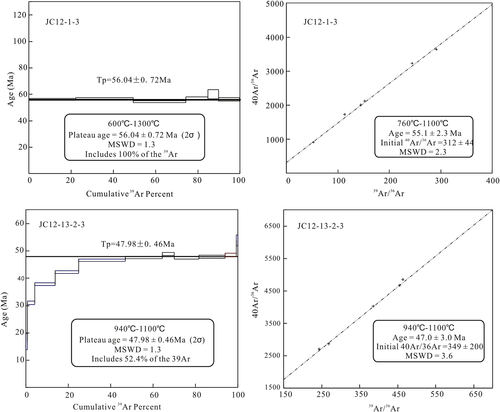
6 DISCUSSION
6.1 Timing of the structural deformation
Judging by the Ar–Ar plateau ages (56.04 ± 0.72 Ma, 47.98 ± 0.46 Ma) of the sericite in the two quartz veins that are arranged along the axial plane cleavage of the folders in the D3 stage, the widely distributed quartz veins in the Langjiexue Group are mainly the outcome of fluid action accompanied by the structural deformations in this stage. This shows that these structural deformations mainly occurred in the main Indo-Asian collision orogenesis period, and underwent at least two stages, thus forming the large antiform in the Songre Formation and the large antiform and synform in the Tectonic mélange belt. This also shows that the structural deformations of the Langjiexue Group in the D1 and D2 stages occurred prior to the Indo-Asian collision orogenesis; specifically, the Langjiexue Group had undergone two stages of intense structural compression deformations and foliation replacement prior to the Indo-Asian continental collision. The period of the D3 stage of structural deformations of the Langjiexue Group was consistent with the mineralogenetic epoch of the Bangbu orogenic gold deposits in the region (Pei et al., 2016). The ore-bearing quartz veins of the Bangbu gold deposit had a low-angle oblique crossing with the axial plane of the D2 stage of folds, and the formation of the ore-containing space was correlated with the D3 stage of fold deformations. In addition, the D4 stage of structural deformations of the Langjiexue Group occurred after the main Indo-Asian collision period. The tectonic foliation in the southern part was transformed to lean southwards, perhaps due to the large back overthrust represented by the southwards-inclined Qusong–Cuogu–Zhemulang brittle–ductile shear zone (Figure 4).
6.2 Control of structure over the orogenic gold deposits in Langjiexue group
It has been proved that the flow of large amounts of fluid in the region and the concentration of the gold and sulphur in the fluid are the key prerequisites for the formation of economic orogenic gold deposits (Loucks & Mavrogenes, 1999). The crustal structure is the principle channel for the migration of large scale of ore-forming fluid, whereas the secondary or the third grade structures are the key place for gold aggregation and precipitation (Neumayr, Hagemann, & Couture, 2000). The structures experience times of activities and reactive history and are dominated by high-angle reverse fracture system or thrust nappe shear zone. The transition position of brittle and ductile deformation often controls the spatial orientation of the gold ore body.
Some advocates of orogenic gold deposits do not seem to advocate that the Alps Himalayan collision orogenic belt can form large gold deposits, because they believe that their vertical fracture systems are small in scale, shallow in depth, and poor in connectivity of tectonic networks (Barley & Groves, 1992; Hou et al., 2006; Huang, Zhao, Zhu, & Gao, 2017). In fact, this is not the case in the Himalayan orogenic belt. The IYS has become the most important boundary fault and translithospheric fracture in the Lhasa block due to the subduction of the Neo-Tethyan ocean before the Indo-Asian collision. Since 65 Ma, the Indian Plate subducted to the Asian Plate and the Indo-Asian collision absorbed 130–140 km crustal shortening (Yin & Harrison, 2000). The IYS has been strongly superimposed and transformed as the main boundary fracture of the continental collision between Asian and Indian plates, whose south side was destroyed by the large southward reverse thrust fault (GCT) accompanied by the secondary fracture, whereas the north side was reformed by the Gangdese northward thrusting fault system (GC) with ENE large shear zone developed simultaneously. The peak metamorphism triggered by Indo-Asian collision released a large amount of CO2-rich metamorphic fluids. The thrusting was the principle deep pressure mechanism of the fluid, and these thrusting zones provided migration channels for the large scale fluid. The Qusong–Cuogu–Zhemulang brittle–ductile shear zone in Langjiexue Group was the secondary fracture of IYS that can accumulate the deep source fluid through the pumping effect periodically (Figure 9). The folds and fracture structures in the Langjiexue Group were well developed, which provide a good trap environment for the precipitation of gold. The gold ore bodies of the Bangbu and Zhemulang deposits were controlled by numbers of typical third-class structures behaving as asymmetrical semitight equal-thick or sharp prismatic folds resulted from the nearly north–south-trending compressional stress (the D3 stage) in the region (Figure 9).

7 CONCLUSION
- The structural deformations of the Langjiexue Group can be divided into four stages. In the D1 stage, shallow ductile shear played a dominant role with the principal stress of the reaction in a nearly E–W direction. The main stress of D2 stage was in an obviously S–N direction with the foliation of the axial surface of this stage was a ubiquitous phyllitic foliation and foliation. The structures of the D3 stage were superimposed on those of the D2 stage with the main stress of S–N direction. In the D4 stage, the principal stress of the tectonic movements was in a nearly E–W direction. The main body of the Songre Formation in the southern parts of the tectonic profiles can be restored into a large reverse antiform, and the main body of the Tectonic mélange belt can be restored into a continuous large antiform and synform.
- Judging by the Ar–Ar plateau ages (56.04 ± 0.72 Ma, 47.98 ± 0.46 Ma) of the sericite in the two quartz veins that are arranged along the axial plane cleavage of the folders D3 stage, the widely distributed quartz veins in the Langjiexue Group were mainly the outcome of fluid action accompanied by the structural deformation that occurred in the main Indo-Asian collision orogenesis period, which were in consistent with the mineralogenetic epoch of the orogenic gold deposits in the Langjiexue Group.
ACKNOWLEDGEMENTS
We thank Linyuan Zhang, Ning Wen, and Zhe Liu for the field work and sample preparation. This work was funded by the National Key Research and Development Project of China (2016YFC0600307), Fundamental Research Funds for the Chinese Academy of Geological Sciences (K1709), and National Natural Science Foundation Project (4170020919, 41773042, 41403043).



